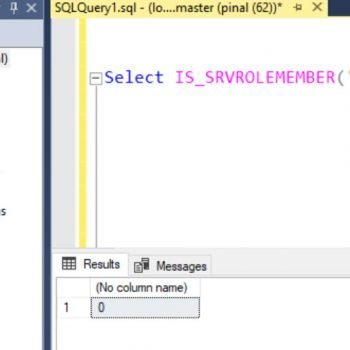[Note from Pinal]: This is an 87th episode of Notes from the Field series. Every week, I personally wait for the notes from the fields from Mike because it contains lessons of life which directly impacts DBA and Developer’s life positively. Mike Walsh is an amazing person to meet and know. I am fortunate to be his friend. Every single time I meet him, I learn something as a human. He is always looking for an opportunity to improve the life of DBAs and Developers. Let us learn about Disabled CPU Power Saving.
 Mike normally talks about something that impacts a client, impacts DBAs or a professional development topic. However, in today’s blog post Mike has something very interesting and very helpful to the ever DBA in the world.
Mike normally talks about something that impacts a client, impacts DBAs or a professional development topic. However, in today’s blog post Mike has something very interesting and very helpful to the ever DBA in the world.
Read the entire story in his own words.
 A WellDBA exam is basically an extensive health check of a SQL Server environment. We are looking for small and simple changes to help performance, reliability or manageability. We are looking for deeper changes that could be made to help in these areas and we are helping clients see what sort of architecture decisions and foundational decisions should be addressed to scale into the future.
A WellDBA exam is basically an extensive health check of a SQL Server environment. We are looking for small and simple changes to help performance, reliability or manageability. We are looking for deeper changes that could be made to help in these areas and we are helping clients see what sort of architecture decisions and foundational decisions should be addressed to scale into the future.
We have a free checklist you can use to check your own servers also. It describes some of our most common findings and helps you get on the road to having a healthy and a scalable SQL Server environment. You can download it and review your own environment to make sure you are following best practices.
Power Saving?! Hasn’t the SQL Family Talked About That A Lot?!?
Yes! There are posts everywhere about it and why it isn’t great for SQL Servers. Even still – it is something we find on at least 70% of the WellDBA exams we provide to customers. These are customers of all sorts and sizes with all manner of DBA teams or accidental DBAs at the helm.
So… Yes. A reminder about this setting.
What’s This All About?
Processors today have a Power Saving setting on them. They allow themselves to basically be told to operate at a lower performance profile to cut down on power costs. When the CPU gets really busy – the performance may be ramped up – then it ramps back down.
This sounds great in theory – but SQL Server isn’t normally just pegging the CPU – so the CPU performance may never go all the way up – and when it does, it often will go up just as the demand period is over and the boost isn’t needed.
The default on most Windows Server installations is “Balanced Mode” – this means out of the box you are allowing Windows to under clock your CPU experience and only increase it as/when/if needed.
Another way of saying it – you’ve taken your SQL Server instance – which you’ve licensed by CPU core nowadays – and forced it to run on lower power CPUs then you paid for when buying the server and paid for when licensing SQL Server.
What can you do?
Three simple steps really:
- See if you are running in balanced mode – You can go to start and then run and type in powercfg.cpl (or browse to control panel and then power settings). And see if you are running in balanced or High Performance.
- If running in balanced – change it to High Performance
- Consider making a group policy for your SQL Server servers and make sure they always run in High Performance mode.
- Celebrate that you are getting the performance you expected and paid for.
My plea for you is that you will just check this setting yourself and fix it for yourself. You won’t see queries take 200% less time, but you could get a boost in performance to some degree, sometimes even a 10-30% increase.
Reference: Pinal Dave (https://blog.sqlauthority.com)






2 Comments. Leave new
Hi Pinal
The link to the free checklist works fine but the form on the landing page does not end up sending an email…
Cheers, Jerry
Hi Jerry,
Thanks for bringing that to our attention. Looks like a recent wordpress plugin update/change caused an issue. We’ve put a redirect in to a new form and the e-mailer is working there – I just tested it. So sorry!